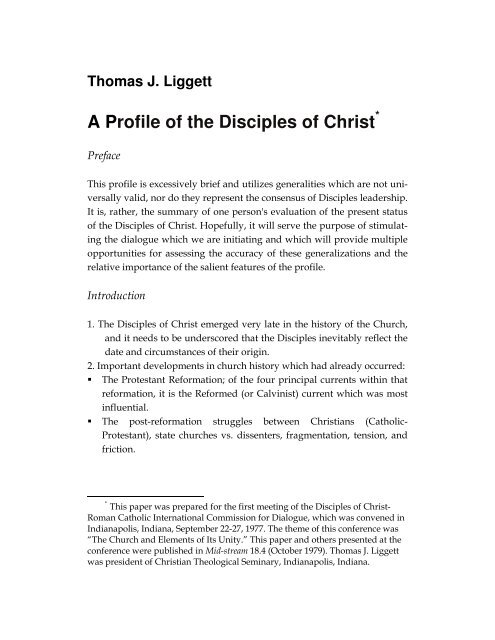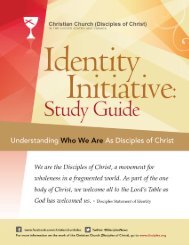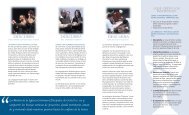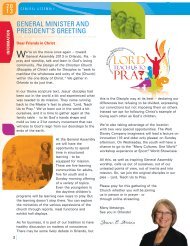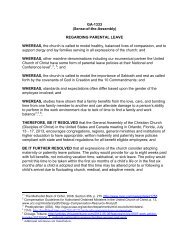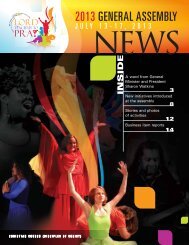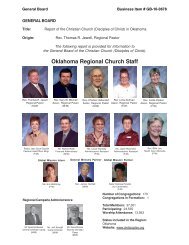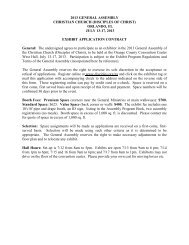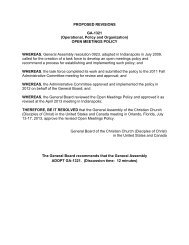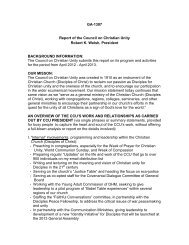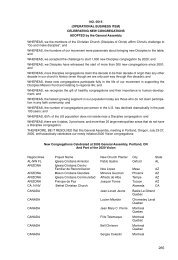"A Profile of the Disciples of Christ" by T.J. Liggett - Christian Church ...
"A Profile of the Disciples of Christ" by T.J. Liggett - Christian Church ...
"A Profile of the Disciples of Christ" by T.J. Liggett - Christian Church ...
Create successful ePaper yourself
Turn your PDF publications into a flip-book with our unique Google optimized e-Paper software.
Thomas J. <strong>Liggett</strong>A <strong>Pr<strong>of</strong>ile</strong> <strong>of</strong> <strong>the</strong> <strong>Disciples</strong> <strong>of</strong> Christ *PrefaceThis pr<strong>of</strong>ile is excessively brief and utilizes generalities which are not universallyvalid, nor do <strong>the</strong>y represent <strong>the</strong> consensus <strong>of</strong> <strong>Disciples</strong> leadership.It is, ra<strong>the</strong>r, <strong>the</strong> summary <strong>of</strong> one person's evaluation <strong>of</strong> <strong>the</strong> present status<strong>of</strong> <strong>the</strong> <strong>Disciples</strong> <strong>of</strong> Christ. Hopefully, it will serve <strong>the</strong> purpose <strong>of</strong> stimulating<strong>the</strong> dialogue which we are initiating and which will provide multipleopportunities for assessing <strong>the</strong> accuracy <strong>of</strong> <strong>the</strong>se generalizations and <strong>the</strong>relative importance <strong>of</strong> <strong>the</strong> salient features <strong>of</strong> <strong>the</strong> pr<strong>of</strong>ile.Introduction1. The <strong>Disciples</strong> <strong>of</strong> Christ emerged very late in <strong>the</strong> history <strong>of</strong> <strong>the</strong> <strong>Church</strong>,and it needs to be underscored that <strong>the</strong> <strong>Disciples</strong> inevitably reflect <strong>the</strong>date and circumstances <strong>of</strong> <strong>the</strong>ir origin.2. Important developments in church history which had already occurred: The Protestant Reformation; <strong>of</strong> <strong>the</strong> four principal currents within thatreformation, it is <strong>the</strong> Reformed (or Calvinist) current which was mostinfluential. The post-reformation struggles between <strong>Christian</strong>s (Catholic-Protestant), state churches vs. dissenters, fragmentation, tension, andfriction.* This paper was prepared for <strong>the</strong> first meeting <strong>of</strong> <strong>the</strong> <strong>Disciples</strong> <strong>of</strong> Christ-Roman Catholic International Commission for Dialogue, which was convened inIndianapolis, Indiana, September 22-27, 1977. The <strong>the</strong>me <strong>of</strong> this conference was“The <strong>Church</strong> and Elements <strong>of</strong> Its Unity.” This paper and o<strong>the</strong>rs presented at <strong>the</strong>conference were published in Mid-stream 18.4 (October 1979). Thomas J. <strong>Liggett</strong>was president <strong>of</strong> <strong>Christian</strong> Theological Seminary, Indianapolis, Indiana.
2A <strong>Pr<strong>of</strong>ile</strong> <strong>of</strong> <strong>the</strong> <strong>Disciples</strong> <strong>of</strong> Christ The evangelical/pietist movement had already made its impact in bothGreat Britain and in <strong>the</strong> American colonies. The enlightment/aufklarung had already occurred, leaving its legacy <strong>of</strong>science and empirical thought in western Europe.3. The English-speaking context: <strong>the</strong> rootage <strong>of</strong> <strong>the</strong> <strong>Disciples</strong> <strong>of</strong> Christ isfound in Great Britain and in <strong>the</strong> United States <strong>of</strong> America (a nationformed from former British colonies).I. An Outline <strong>of</strong> <strong>the</strong> <strong>Disciples</strong> <strong>of</strong> Christ Internationally IdentifiedGreat Britain The movements in Scotland and Ireland which led to <strong>the</strong> formation <strong>of</strong><strong>the</strong> <strong>Church</strong>es <strong>of</strong> Christ in Great Britain date from <strong>the</strong> late 18th century.They were characterized <strong>by</strong> a critical stance with regard to <strong>the</strong> establishedchurches, and <strong>by</strong> a search for an understanding <strong>of</strong> <strong>the</strong> Gospeland a church life-style which would be based exclusively upon <strong>the</strong>New Testament. From <strong>the</strong>se origins in Great Britain, <strong>the</strong> movement began to spread tosome <strong>of</strong> <strong>the</strong> overseas dominions <strong>of</strong> <strong>the</strong> empire: Canada, 1811; NewZealand, 1843; Australia, 1845; South Africa, 1900. The churches in Great Britain and in <strong>the</strong> dominions engaged in missionarywork, usually <strong>by</strong> separate initiative, which resulted in <strong>the</strong>emergence <strong>of</strong> mission churches, principally in India, Rhodesia, in o<strong>the</strong>rBritish colonies in Africa, and in Thailand.B. United States <strong>of</strong> America The <strong>Disciples</strong> <strong>of</strong> Christ in <strong>the</strong> USA have a dual rootage: (1) <strong>the</strong> initiative<strong>of</strong> immigrants from Great Britain (Thomas Campbell and AlexanderCampbell), and (2) an entirely separate and indigenous movementon <strong>the</strong> western frontier (Barton W. Stone). These two movementsmerged in 1832. They shared such important elements as a search for<strong>Christian</strong> unity, a desire to return to New Testament <strong>Christian</strong>ity, andThis reformatted, electronic edition, published online in 2012, is authorized<strong>by</strong> <strong>the</strong> Council on <strong>Christian</strong> Unity <strong>of</strong> <strong>the</strong> <strong>Christian</strong> <strong>Church</strong> (<strong>Disciples</strong> <strong>of</strong> Christ),publisher <strong>of</strong> Mid-stream.
A <strong>Pr<strong>of</strong>ile</strong> <strong>of</strong> <strong>the</strong> <strong>Disciples</strong> <strong>of</strong> Christ 3reflected many <strong>of</strong> <strong>the</strong> values and attitudes <strong>of</strong> <strong>the</strong> early 19th centuryAmerican frontier. From this beginning in <strong>the</strong> USA, <strong>the</strong> <strong>Disciples</strong> <strong>of</strong> Christ enlarged <strong>the</strong>irinternational horizons in two ways: (1) <strong>the</strong>y established fraternal relationshipswith <strong>Church</strong>es <strong>of</strong> Christ in <strong>the</strong> British Empire (Great Britain,Canada, New Zealand, Australia and South Africa). The relationshipswere cordial and fraternal, without any international structural patterns<strong>of</strong> dependency or control between <strong>the</strong> churches. (2) The secondpattern <strong>of</strong> international expansion was through <strong>the</strong> foreign missionwork. In <strong>the</strong> 19th century. “Mission churches” came into being in India,Jamaica, Japan, Mexico, China, Puerto Rico, Africa (Zaire). In <strong>the</strong>20th century, o<strong>the</strong>r <strong>Disciples</strong> churches emerged in <strong>the</strong> Philippines, Argentina,and Paraguay, and relationships were established with somechurches which were started <strong>by</strong> <strong>the</strong> British <strong>Disciples</strong>, such as in Thailand.C. In <strong>the</strong> first half <strong>of</strong> <strong>the</strong> 20th century, <strong>the</strong>re were some contacts and fellowshipwith churches in Poland and Russia whose general characterand perspectives were similar to <strong>the</strong> <strong>Disciples</strong> in countries alreadymentioned.D. With improved transportation and communication and increased contactbetween <strong>the</strong> churches, <strong>the</strong>re emerged an awareness <strong>of</strong> being amovement with worldwide dimensions. However, <strong>the</strong> strength <strong>of</strong> <strong>the</strong>church was predominantly in <strong>the</strong> English-speaking world and nearly80% <strong>of</strong> <strong>the</strong> members were in North America. Only in <strong>the</strong> “missionchurches” had <strong>the</strong> movement transcended <strong>the</strong> cultural context <strong>of</strong> itsorigin.E. The ways in which <strong>the</strong> <strong>Disciples</strong> have transcended <strong>the</strong> limits <strong>of</strong> <strong>the</strong>secountries where <strong>the</strong>re were identifiable <strong>Disciples</strong> churches will berecognized at a later point <strong>of</strong> this paper.II. Selected Continuing Themes with New ExpressionsA. Dealing with <strong>the</strong> God-given unity <strong>of</strong> <strong>the</strong> <strong>Church</strong>. Early founders understood that <strong>Christian</strong> unity was both a gift and agoal; <strong>the</strong>y affirmed that <strong>the</strong> <strong>Church</strong> <strong>of</strong> Jesus Christ on earth is inten-
4A <strong>Pr<strong>of</strong>ile</strong> <strong>of</strong> <strong>the</strong> <strong>Disciples</strong> <strong>of</strong> Christtionally, constitutionally, and essentially one. They sought to give expressionto this oneness through a simple process <strong>of</strong> “restoring <strong>the</strong>New Testament <strong>Church</strong>,” <strong>by</strong>passing most <strong>of</strong> <strong>Christian</strong> history andeliminating “human things” (creeds, confessions, structures, etc.)which were seen as <strong>the</strong> real cause <strong>of</strong> division. Some would see this restorationapproach to <strong>Christian</strong> unity as overly simplistic and naive.History certainly demonstrates that it did not achieve <strong>the</strong> unity whichwas originally sought. With <strong>the</strong> rise <strong>of</strong> <strong>the</strong> modern ecumenical movement, <strong>the</strong> <strong>Disciples</strong> respondedwith enthusiasm, that is, <strong>the</strong> majority <strong>of</strong> <strong>the</strong>m. A minorityseparated from <strong>the</strong> main stream and continues <strong>the</strong> “restorationist approach,”understood in legalistic and scholastic terms. But <strong>the</strong> record isclear that in most parts <strong>of</strong> <strong>the</strong> world, <strong>the</strong> <strong>Disciples</strong> welcomed and gaveearly support to <strong>the</strong> ecumenical movement. We participate in cooperativeventures and church councils on every continent, were foundingmembers <strong>of</strong> many national councils <strong>of</strong> churches and <strong>of</strong> <strong>the</strong> WorldCouncil <strong>of</strong> <strong>Church</strong>es. Mission strategy was altered in keeping with this new understanding<strong>of</strong> <strong>the</strong> reality <strong>of</strong> <strong>the</strong> one church. We have ceased efforts to found new“<strong>Disciples</strong> churches” in new countries, but ra<strong>the</strong>r have chosen to workwith existing churches in many parts <strong>of</strong> <strong>the</strong> world where <strong>the</strong>re are noidentifiable <strong>Disciples</strong> churches (Zambia, Kenya, Venezuela, Brazil, Bolivia,Indonesia, Hong Kong, etc.). Encouragement has been given to“younger churches” to explore <strong>the</strong> possibility <strong>of</strong> <strong>Christian</strong> union in<strong>the</strong>ir respective countries. Increasing amounts <strong>of</strong> resources are channeledthrough ecumenical agencies ra<strong>the</strong>r than denominationally, anda formal position has been taken indicating a preference for an ecumenicalapproach to mission. The oneness <strong>of</strong> <strong>the</strong> church has impacted <strong>the</strong> internal life and structure<strong>of</strong> <strong>the</strong> church. In our earlier history, we tended to speak <strong>of</strong> <strong>the</strong> localcongregation as <strong>the</strong> “church” and to refer to national expressions as“conferences" or “conventions” <strong>of</strong> churches. Increasingly throughout<strong>the</strong> world, <strong>the</strong> national entity is referred to in <strong>the</strong> singular, <strong>Christian</strong><strong>Church</strong> (<strong>Disciples</strong> <strong>of</strong> Christ) ra<strong>the</strong>r than <strong>the</strong> plural, and structures andmethods <strong>of</strong> decision-maki.ng are giving expression to this new under-
A <strong>Pr<strong>of</strong>ile</strong> <strong>of</strong> <strong>the</strong> <strong>Disciples</strong> <strong>of</strong> Christ 5standing <strong>of</strong> <strong>the</strong> “one church.” This is especially true <strong>of</strong> <strong>the</strong> process <strong>of</strong>restructure <strong>of</strong> <strong>the</strong> church in <strong>the</strong> USA and Canada, but is not limited tothis particular church. The oneness <strong>of</strong> <strong>the</strong> <strong>Church</strong> has also led us to <strong>the</strong> serious consideration<strong>of</strong> actual church union. We are participants in <strong>the</strong> Consultation on<strong>Church</strong> Union in <strong>the</strong> USA, and will be making a decision within a fewweeks on <strong>the</strong> proposal for serious union conversations with <strong>the</strong> United<strong>Church</strong> <strong>of</strong> Christ. Overseas, <strong>the</strong> <strong>Disciples</strong> churches in Zaire, South Africa,Philippines, Japan, India, and Thailand are already a part <strong>of</strong> aUnited <strong>Church</strong> in each country. (In <strong>the</strong> <strong>Church</strong> <strong>of</strong> Christ in Zaire, denominationalgroups continue as identifiable communities within <strong>the</strong>united church.) Participation in bilateral conversations with <strong>Christian</strong>s <strong>of</strong> o<strong>the</strong>r traditionsis ano<strong>the</strong>r important dimension <strong>of</strong> our contemporary dealingwith <strong>the</strong> God-given unity <strong>of</strong> <strong>the</strong> <strong>Church</strong>. The whole church tradition has achieved a new importance for <strong>the</strong><strong>Disciples</strong>. In our early history, <strong>the</strong> emphasis on restoration tended toeclipse <strong>the</strong> post-biblical history <strong>of</strong> <strong>the</strong> <strong>Church</strong>. We were impoverished<strong>by</strong> our ignorance and nonuse <strong>of</strong> <strong>the</strong> treasures <strong>of</strong> this history. Now, <strong>the</strong>unity <strong>of</strong> <strong>the</strong> <strong>Church</strong>—both <strong>the</strong> <strong>Church</strong> triumphant as well as militant—has brought a new sense <strong>of</strong> “ownership” to <strong>the</strong> historic <strong>Church</strong>. This isclearly seen in <strong>the</strong> hymnbooks, symbols, liturgy, architecture, and <strong>the</strong>curriculum <strong>of</strong> <strong>the</strong>ological schools. <strong>Christian</strong> unity is an old <strong>the</strong>me for <strong>Disciples</strong>—but it has many new andfresh expressions in our recent history and present reality.B. Thinking about religion in new, creative, and relevant ways: The <strong>Disciples</strong> appeared in history after <strong>the</strong> beginning <strong>of</strong> modern science.Scholars have demonstrated how important for our beginningswere <strong>the</strong> influences which came from early scientific thinking. Especiallywe are indebted to John Locke and English empiricism. We havelong known <strong>the</strong> value <strong>of</strong> holding a proposition as an hypo<strong>the</strong>sis and<strong>the</strong> importance <strong>of</strong> continual reexamination <strong>of</strong> evidence and new light.
6A <strong>Pr<strong>of</strong>ile</strong> <strong>of</strong> <strong>the</strong> <strong>Disciples</strong> <strong>of</strong> Christ After <strong>the</strong> early years <strong>of</strong> our founders, <strong>the</strong> <strong>Disciples</strong> had a period <strong>of</strong>“scholasticism” which was limited to <strong>the</strong> reiteration <strong>of</strong> <strong>the</strong> early formulaewithout any au<strong>the</strong>ntic creativity. But near <strong>the</strong> end <strong>of</strong> <strong>the</strong> 19th century,<strong>the</strong>re was a resurgence <strong>of</strong> <strong>the</strong> early spirit in new forms. Historicalcriticism was increasingly embraced and used and <strong>the</strong> <strong>Disciples</strong> beganto participate actively in <strong>the</strong> development <strong>of</strong> “liberalism” as it soughtto think about religion in creative and relevant ways. The rise <strong>of</strong> neo-orthodoxy made an impact upon <strong>Disciples</strong> seminariesand brought a healthy chastening to <strong>the</strong> more audacious forms <strong>of</strong> liberalism.But it did not have a lasting impact on <strong>Disciples</strong> thinking. For a brief time in <strong>the</strong> 1960s, <strong>Disciples</strong> (along with o<strong>the</strong>r <strong>Christian</strong>s in<strong>the</strong> West) were confronted with <strong>the</strong> radical <strong>the</strong>ologians. Attention wasgiven to <strong>the</strong>ir seemingly nihilistic onslaught on traditional <strong>Christian</strong>doctrines, but generally <strong>Disciples</strong> did not enter <strong>the</strong> camp <strong>of</strong> <strong>the</strong> radical<strong>the</strong>ologians. Today, <strong>the</strong>re is a growing and promising exploration in what somewould call neo-liberalism. A better term is “process <strong>the</strong>ology.” It isrooted in <strong>the</strong> philosophy <strong>of</strong> Whitehead and represents <strong>the</strong> most promisingattempt to state <strong>the</strong> meaning <strong>of</strong> <strong>the</strong> <strong>Christian</strong> faith in terms andcategories which modern men can understand and accept. While it isstill too early to assess its capability <strong>of</strong> becoming a major trend, it doesfall clearly within <strong>the</strong> <strong>Disciples</strong> tradition <strong>of</strong> thinking about religion innew, creative, and relevant ways.C. Dialogues and debates: The early history <strong>of</strong> <strong>the</strong> <strong>Disciples</strong> was characterized <strong>by</strong> a special interestin <strong>the</strong> public debate <strong>of</strong> what were, at that time, issues <strong>of</strong> great concernfor church leaders. Most <strong>of</strong> <strong>the</strong>se debates were characterized <strong>by</strong> aconfrontation <strong>of</strong> opposites, and would not properly fall into <strong>the</strong> category<strong>of</strong> dialogue. Most <strong>of</strong> <strong>the</strong>se debates were with o<strong>the</strong>r <strong>Christian</strong>s(<strong>the</strong>re was <strong>the</strong> notable exception <strong>of</strong> <strong>the</strong> Campbell-Owen debate <strong>of</strong>1829). Since most <strong>of</strong> our debating was with fellow-<strong>Christian</strong>s, <strong>the</strong> better termwould be “polemics”—discussions between persons where <strong>the</strong> spirit <strong>of</strong><strong>the</strong> discussion tends to be one <strong>of</strong> antagonism and in which relatively
A <strong>Pr<strong>of</strong>ile</strong> <strong>of</strong> <strong>the</strong> <strong>Disciples</strong> <strong>of</strong> Christ 7minor topics are dealt with, ra<strong>the</strong>r than major topics. Polemics can leada religious movement into developing unwholesome attitudes and inordinateexpertise in relatively minor issues. Apologetics, on <strong>the</strong> o<strong>the</strong>r hand, are developed in an encounter witho<strong>the</strong>r persons or movements in which <strong>the</strong> discussion deals with major<strong>the</strong>mes and fundamental issues. It would be fair to say that in our earlier history, <strong>Disciples</strong> were excessivelyengaged in debates among <strong>the</strong>mselves and with o<strong>the</strong>r <strong>Christian</strong>swhich were polemical in nature and tended to exaggerate <strong>the</strong> importance<strong>of</strong> relatively minor issues and to over-emphasize <strong>the</strong> beliefsand practices which separate <strong>Christian</strong>s from one ano<strong>the</strong>r. In our recent history, <strong>the</strong> <strong>Disciples</strong> have increasingly developed a concernfor and participation in dialogues in which differences are not ignored,but in which <strong>the</strong>re is a spirit <strong>of</strong> mutual understanding andcommon search. <strong>Disciples</strong> have entered broadly in dialogue with fellow-<strong>Christian</strong>s.The General Assembly <strong>of</strong> <strong>the</strong> <strong>Christian</strong> <strong>Church</strong> in <strong>the</strong>USA and Canada will consider within a few weeks a formal declaration<strong>of</strong> encouragement <strong>of</strong> a Jewish-<strong>Christian</strong> dialogue. <strong>Disciples</strong> haveparticipated in <strong>the</strong> program <strong>of</strong> <strong>the</strong> World Council <strong>of</strong> <strong>Church</strong>es in <strong>the</strong><strong>Christian</strong>/Marxist dialogue program. The literature <strong>of</strong> <strong>the</strong> WCC explorationsin dialogue with Muslims and Hindus is to be found in <strong>the</strong> libraries<strong>of</strong> <strong>Disciples</strong> seminaries. In our early history, we had considerable competence in <strong>the</strong> skills <strong>of</strong>debate and polemics, which <strong>of</strong>ten led us to distort <strong>the</strong> relative importance<strong>of</strong> <strong>the</strong> topics and to overemphasize our differences, among<strong>Disciples</strong> and between <strong>Disciples</strong> and o<strong>the</strong>r <strong>Christian</strong>s. Today, we discovera new dialogical posture in <strong>the</strong> <strong>Disciples</strong> church which givesgreat promise because <strong>of</strong> <strong>the</strong> spirit <strong>of</strong> mutual sharing and discoverywhich it contains, and because <strong>of</strong> <strong>the</strong> depth and importance <strong>of</strong> <strong>the</strong> issueswhich constitute its agenda.D. Rethinking mission: In <strong>the</strong> early history <strong>of</strong> <strong>the</strong> <strong>Disciples</strong> church, much <strong>of</strong> <strong>the</strong> writing andpreaching seems to have been directed toward o<strong>the</strong>r <strong>Christian</strong>s and<strong>the</strong>re were actually instances in which whole congregations who were


